PGBM143: Global Strategy and International Trade Project Analysis
VerifiedAdded on 2022/12/29
|15
|5199
|53
Report
AI Summary
This report provides a comprehensive analysis of global strategy and international trade, focusing on the application of strategic alliances, mergers, and acquisitions within the context of Sainsbury's, a multinational retail company. The report begins by defining global strategy and international trade, emphasizing their importance for business expansion and revenue generation. It then delves into the roles of strategic alliances and mergers and acquisitions in achieving corporate profitability and sustainable growth in both international and domestic markets. The analysis includes a critical evaluation of how these strategies enable market diversification, enhance brand recognition, and provide competitive advantages. The report examines Sainsbury's as a case study, exploring its strategic decisions and their impact on market share, customer base, and overall business performance. It highlights the benefits of strategic alliances, such as access to new markets, improved product lines, and enhanced brand reputation, as well as the advantages of mergers and acquisitions, including tax benefits, access to skilled labor, and market diversification. The report concludes by synthesizing the findings and providing insights into the effective implementation of these strategies for sustained business growth.
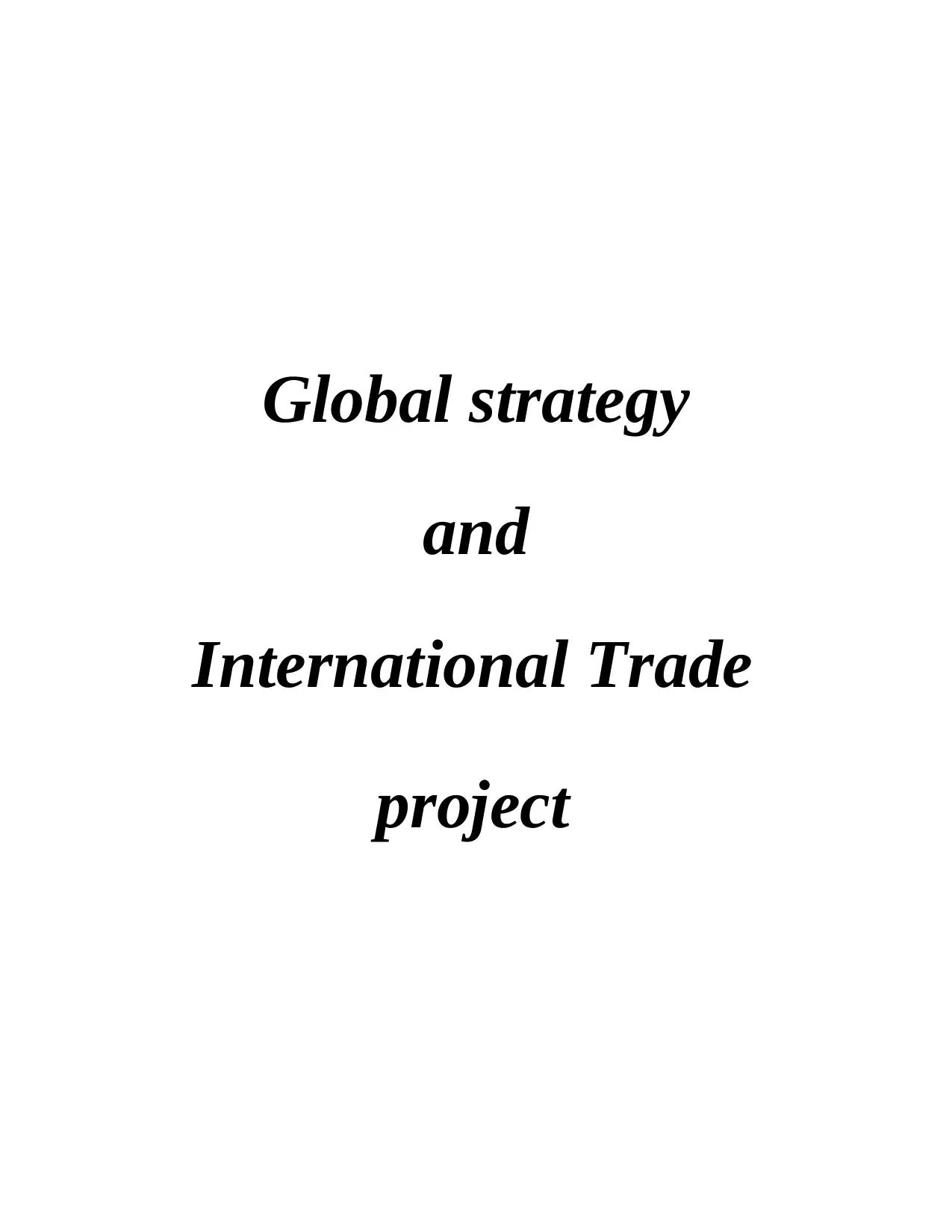
Global strategy
and
International Trade
project
and
International Trade
project
Paraphrase This Document
Need a fresh take? Get an instant paraphrase of this document with our AI Paraphraser
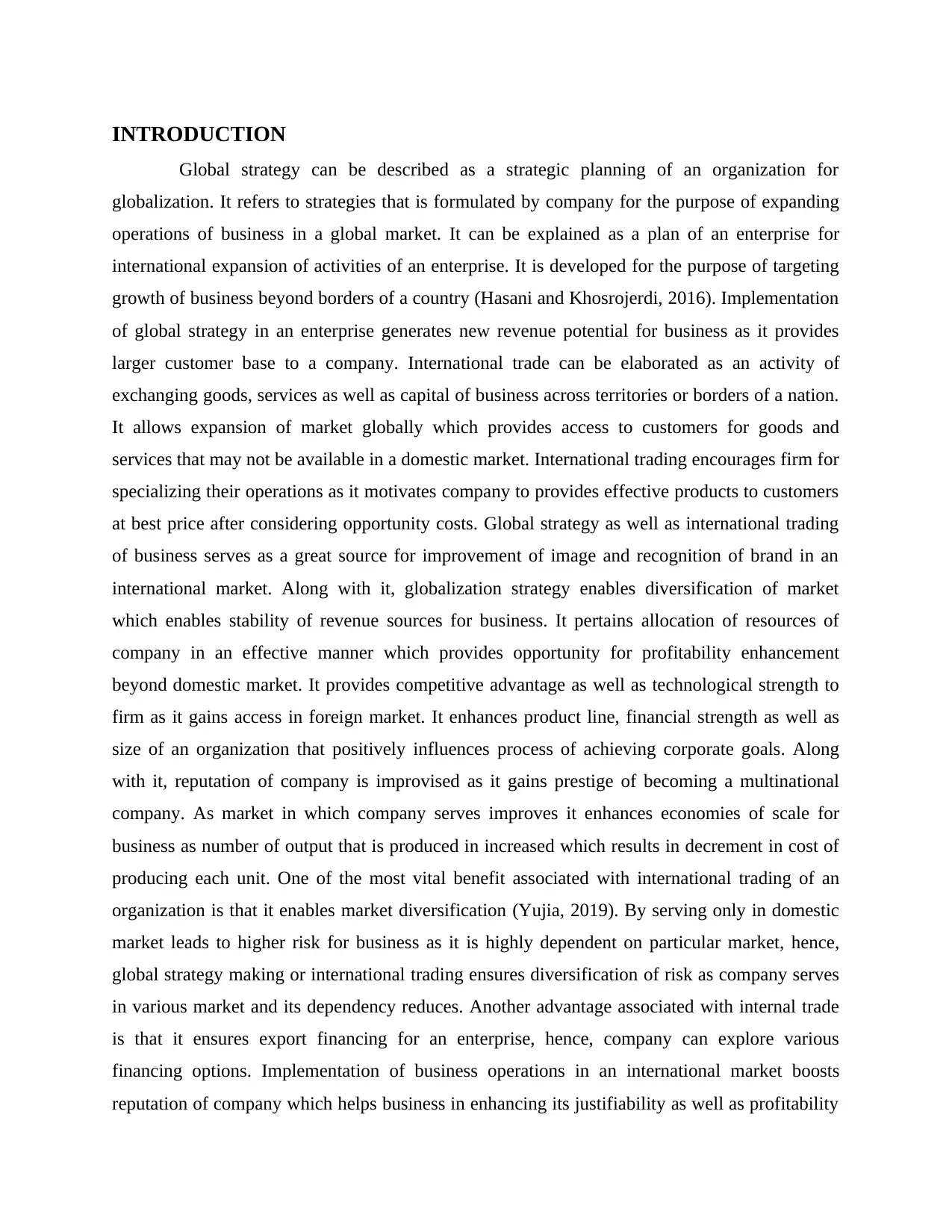
INTRODUCTION
Global strategy can be described as a strategic planning of an organization for
globalization. It refers to strategies that is formulated by company for the purpose of expanding
operations of business in a global market. It can be explained as a plan of an enterprise for
international expansion of activities of an enterprise. It is developed for the purpose of targeting
growth of business beyond borders of a country (Hasani and Khosrojerdi, 2016). Implementation
of global strategy in an enterprise generates new revenue potential for business as it provides
larger customer base to a company. International trade can be elaborated as an activity of
exchanging goods, services as well as capital of business across territories or borders of a nation.
It allows expansion of market globally which provides access to customers for goods and
services that may not be available in a domestic market. International trading encourages firm for
specializing their operations as it motivates company to provides effective products to customers
at best price after considering opportunity costs. Global strategy as well as international trading
of business serves as a great source for improvement of image and recognition of brand in an
international market. Along with it, globalization strategy enables diversification of market
which enables stability of revenue sources for business. It pertains allocation of resources of
company in an effective manner which provides opportunity for profitability enhancement
beyond domestic market. It provides competitive advantage as well as technological strength to
firm as it gains access in foreign market. It enhances product line, financial strength as well as
size of an organization that positively influences process of achieving corporate goals. Along
with it, reputation of company is improvised as it gains prestige of becoming a multinational
company. As market in which company serves improves it enhances economies of scale for
business as number of output that is produced in increased which results in decrement in cost of
producing each unit. One of the most vital benefit associated with international trading of an
organization is that it enables market diversification (Yujia, 2019). By serving only in domestic
market leads to higher risk for business as it is highly dependent on particular market, hence,
global strategy making or international trading ensures diversification of risk as company serves
in various market and its dependency reduces. Another advantage associated with internal trade
is that it ensures export financing for an enterprise, hence, company can explore various
financing options. Implementation of business operations in an international market boosts
reputation of company which helps business in enhancing its justifiability as well as profitability
Global strategy can be described as a strategic planning of an organization for
globalization. It refers to strategies that is formulated by company for the purpose of expanding
operations of business in a global market. It can be explained as a plan of an enterprise for
international expansion of activities of an enterprise. It is developed for the purpose of targeting
growth of business beyond borders of a country (Hasani and Khosrojerdi, 2016). Implementation
of global strategy in an enterprise generates new revenue potential for business as it provides
larger customer base to a company. International trade can be elaborated as an activity of
exchanging goods, services as well as capital of business across territories or borders of a nation.
It allows expansion of market globally which provides access to customers for goods and
services that may not be available in a domestic market. International trading encourages firm for
specializing their operations as it motivates company to provides effective products to customers
at best price after considering opportunity costs. Global strategy as well as international trading
of business serves as a great source for improvement of image and recognition of brand in an
international market. Along with it, globalization strategy enables diversification of market
which enables stability of revenue sources for business. It pertains allocation of resources of
company in an effective manner which provides opportunity for profitability enhancement
beyond domestic market. It provides competitive advantage as well as technological strength to
firm as it gains access in foreign market. It enhances product line, financial strength as well as
size of an organization that positively influences process of achieving corporate goals. Along
with it, reputation of company is improvised as it gains prestige of becoming a multinational
company. As market in which company serves improves it enhances economies of scale for
business as number of output that is produced in increased which results in decrement in cost of
producing each unit. One of the most vital benefit associated with international trading of an
organization is that it enables market diversification (Yujia, 2019). By serving only in domestic
market leads to higher risk for business as it is highly dependent on particular market, hence,
global strategy making or international trading ensures diversification of risk as company serves
in various market and its dependency reduces. Another advantage associated with internal trade
is that it ensures export financing for an enterprise, hence, company can explore various
financing options. Implementation of business operations in an international market boosts
reputation of company which helps business in enhancing its justifiability as well as profitability

in a longer run. Selected multinational company for this report is Sainsbury's. Enterprise operates
in retailing sector and is headquartered in London, United Kingdom. This report consists critical
evaluation of roles of strategic alliance as well as mergers and acquisitions in context to
achievement of sustained growth profitability of corporation over recent years in an international
market as well as domestic market.
.PART A
.Question 1: Critically evaluating roles of strategic alliance and mergers or acquisitions for
enabling achievement of corporate probability as well as sustainable growth of a
corporation in international market and domestic market over recent years:
Overview of company: Sainsbury's serves in retailing industry and it is a multi national
chain of supermarket that is situated in United Kingdom. It is a public limited company that was
founded in the year 1869 and founder of firm was John James Sainsbury. Total number of
employees that works in an organization is approximately 116400. It is a second largest
supermarket chain in United Kingdom with share of 16 percent. Entity is planning to expand its
business operations in Slovakia.
Strategic alliance:
Strategic alliance can be defined as an arrangement in between two organizations for the
purpose of undertaking project which is mutually benefits for both companies while retaining its
interdependence. In comparison to joint venture which states pooling of resources by businesses
and creating separate entity, strategic alliance is less complex or binding. Business enters into
strategic alliance with the motive of expanding its operations in new market, improving product
line of business, or developing edge or advantage over competitors (Mangan and Lalwani, 2016). In
strategic alliance of business, roles or responsibilities of every member is defined clearly. It is
benefits or advantages that is gained by both partners which defines how long coalition will be in
effect. Hence, it refers to a agreement among enterprises that decide to share their resources for
the purpose of undertaking a specific or mutually beneficial project. It helps in developing
process or operations which is more effective for business. It enables working of business
towards correlating objectives. In context to Sainsbury's, strategic alliance is an effective
approach for entering into international market of Slovakia. Strategic alliance of Sainsbury's
with market leader of Slovakia will enable company to acquire large customer base in short
in retailing sector and is headquartered in London, United Kingdom. This report consists critical
evaluation of roles of strategic alliance as well as mergers and acquisitions in context to
achievement of sustained growth profitability of corporation over recent years in an international
market as well as domestic market.
.PART A
.Question 1: Critically evaluating roles of strategic alliance and mergers or acquisitions for
enabling achievement of corporate probability as well as sustainable growth of a
corporation in international market and domestic market over recent years:
Overview of company: Sainsbury's serves in retailing industry and it is a multi national
chain of supermarket that is situated in United Kingdom. It is a public limited company that was
founded in the year 1869 and founder of firm was John James Sainsbury. Total number of
employees that works in an organization is approximately 116400. It is a second largest
supermarket chain in United Kingdom with share of 16 percent. Entity is planning to expand its
business operations in Slovakia.
Strategic alliance:
Strategic alliance can be defined as an arrangement in between two organizations for the
purpose of undertaking project which is mutually benefits for both companies while retaining its
interdependence. In comparison to joint venture which states pooling of resources by businesses
and creating separate entity, strategic alliance is less complex or binding. Business enters into
strategic alliance with the motive of expanding its operations in new market, improving product
line of business, or developing edge or advantage over competitors (Mangan and Lalwani, 2016). In
strategic alliance of business, roles or responsibilities of every member is defined clearly. It is
benefits or advantages that is gained by both partners which defines how long coalition will be in
effect. Hence, it refers to a agreement among enterprises that decide to share their resources for
the purpose of undertaking a specific or mutually beneficial project. It helps in developing
process or operations which is more effective for business. It enables working of business
towards correlating objectives. In context to Sainsbury's, strategic alliance is an effective
approach for entering into international market of Slovakia. Strategic alliance of Sainsbury's
with market leader of Slovakia will enable company to acquire large customer base in short
⊘ This is a preview!⊘
Do you want full access?
Subscribe today to unlock all pages.

Trusted by 1+ million students worldwide
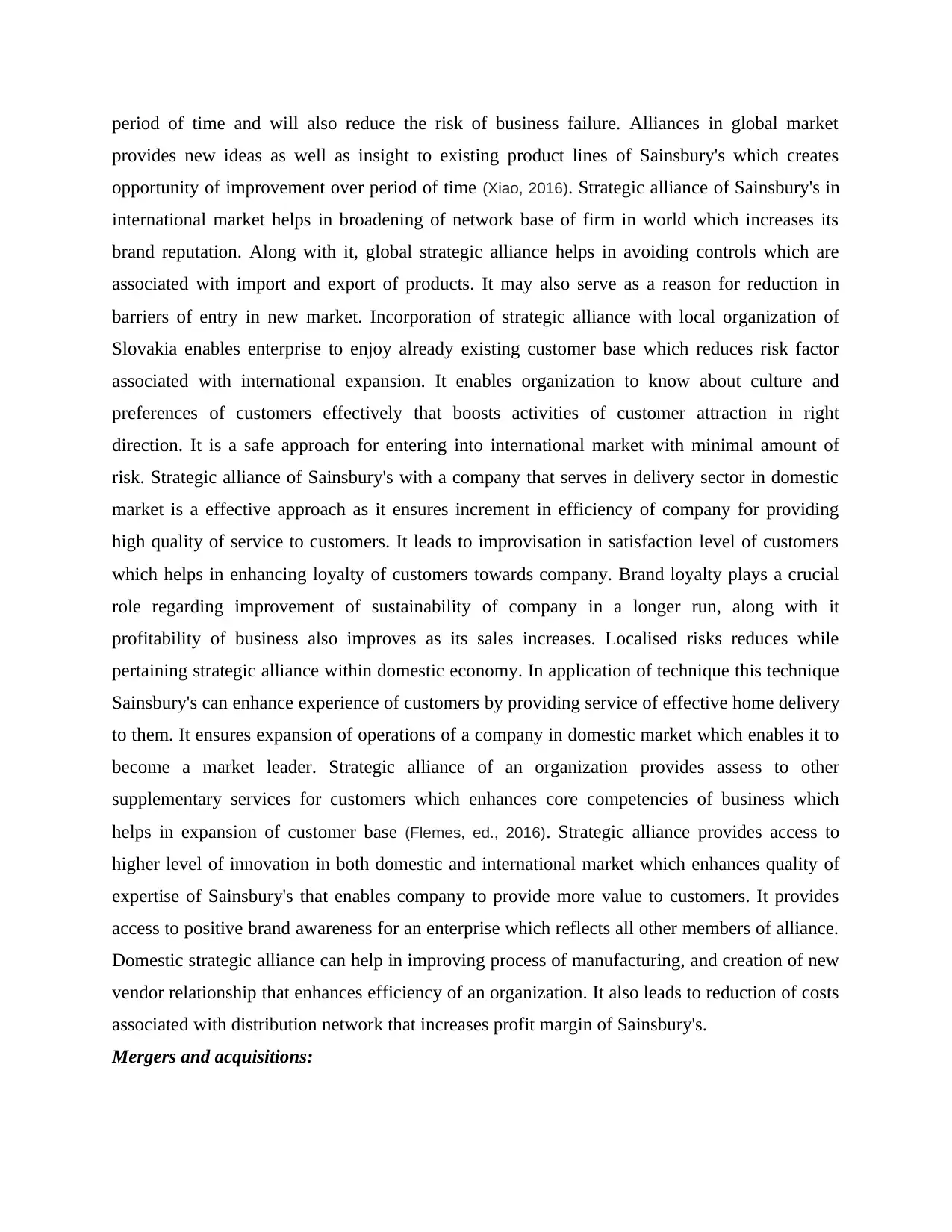
period of time and will also reduce the risk of business failure. Alliances in global market
provides new ideas as well as insight to existing product lines of Sainsbury's which creates
opportunity of improvement over period of time (Xiao, 2016). Strategic alliance of Sainsbury's in
international market helps in broadening of network base of firm in world which increases its
brand reputation. Along with it, global strategic alliance helps in avoiding controls which are
associated with import and export of products. It may also serve as a reason for reduction in
barriers of entry in new market. Incorporation of strategic alliance with local organization of
Slovakia enables enterprise to enjoy already existing customer base which reduces risk factor
associated with international expansion. It enables organization to know about culture and
preferences of customers effectively that boosts activities of customer attraction in right
direction. It is a safe approach for entering into international market with minimal amount of
risk. Strategic alliance of Sainsbury's with a company that serves in delivery sector in domestic
market is a effective approach as it ensures increment in efficiency of company for providing
high quality of service to customers. It leads to improvisation in satisfaction level of customers
which helps in enhancing loyalty of customers towards company. Brand loyalty plays a crucial
role regarding improvement of sustainability of company in a longer run, along with it
profitability of business also improves as its sales increases. Localised risks reduces while
pertaining strategic alliance within domestic economy. In application of technique this technique
Sainsbury's can enhance experience of customers by providing service of effective home delivery
to them. It ensures expansion of operations of a company in domestic market which enables it to
become a market leader. Strategic alliance of an organization provides assess to other
supplementary services for customers which enhances core competencies of business which
helps in expansion of customer base (Flemes, ed., 2016). Strategic alliance provides access to
higher level of innovation in both domestic and international market which enhances quality of
expertise of Sainsbury's that enables company to provide more value to customers. It provides
access to positive brand awareness for an enterprise which reflects all other members of alliance.
Domestic strategic alliance can help in improving process of manufacturing, and creation of new
vendor relationship that enhances efficiency of an organization. It also leads to reduction of costs
associated with distribution network that increases profit margin of Sainsbury's.
Mergers and acquisitions:
provides new ideas as well as insight to existing product lines of Sainsbury's which creates
opportunity of improvement over period of time (Xiao, 2016). Strategic alliance of Sainsbury's in
international market helps in broadening of network base of firm in world which increases its
brand reputation. Along with it, global strategic alliance helps in avoiding controls which are
associated with import and export of products. It may also serve as a reason for reduction in
barriers of entry in new market. Incorporation of strategic alliance with local organization of
Slovakia enables enterprise to enjoy already existing customer base which reduces risk factor
associated with international expansion. It enables organization to know about culture and
preferences of customers effectively that boosts activities of customer attraction in right
direction. It is a safe approach for entering into international market with minimal amount of
risk. Strategic alliance of Sainsbury's with a company that serves in delivery sector in domestic
market is a effective approach as it ensures increment in efficiency of company for providing
high quality of service to customers. It leads to improvisation in satisfaction level of customers
which helps in enhancing loyalty of customers towards company. Brand loyalty plays a crucial
role regarding improvement of sustainability of company in a longer run, along with it
profitability of business also improves as its sales increases. Localised risks reduces while
pertaining strategic alliance within domestic economy. In application of technique this technique
Sainsbury's can enhance experience of customers by providing service of effective home delivery
to them. It ensures expansion of operations of a company in domestic market which enables it to
become a market leader. Strategic alliance of an organization provides assess to other
supplementary services for customers which enhances core competencies of business which
helps in expansion of customer base (Flemes, ed., 2016). Strategic alliance provides access to
higher level of innovation in both domestic and international market which enhances quality of
expertise of Sainsbury's that enables company to provide more value to customers. It provides
access to positive brand awareness for an enterprise which reflects all other members of alliance.
Domestic strategic alliance can help in improving process of manufacturing, and creation of new
vendor relationship that enhances efficiency of an organization. It also leads to reduction of costs
associated with distribution network that increases profit margin of Sainsbury's.
Mergers and acquisitions:
Paraphrase This Document
Need a fresh take? Get an instant paraphrase of this document with our AI Paraphraser
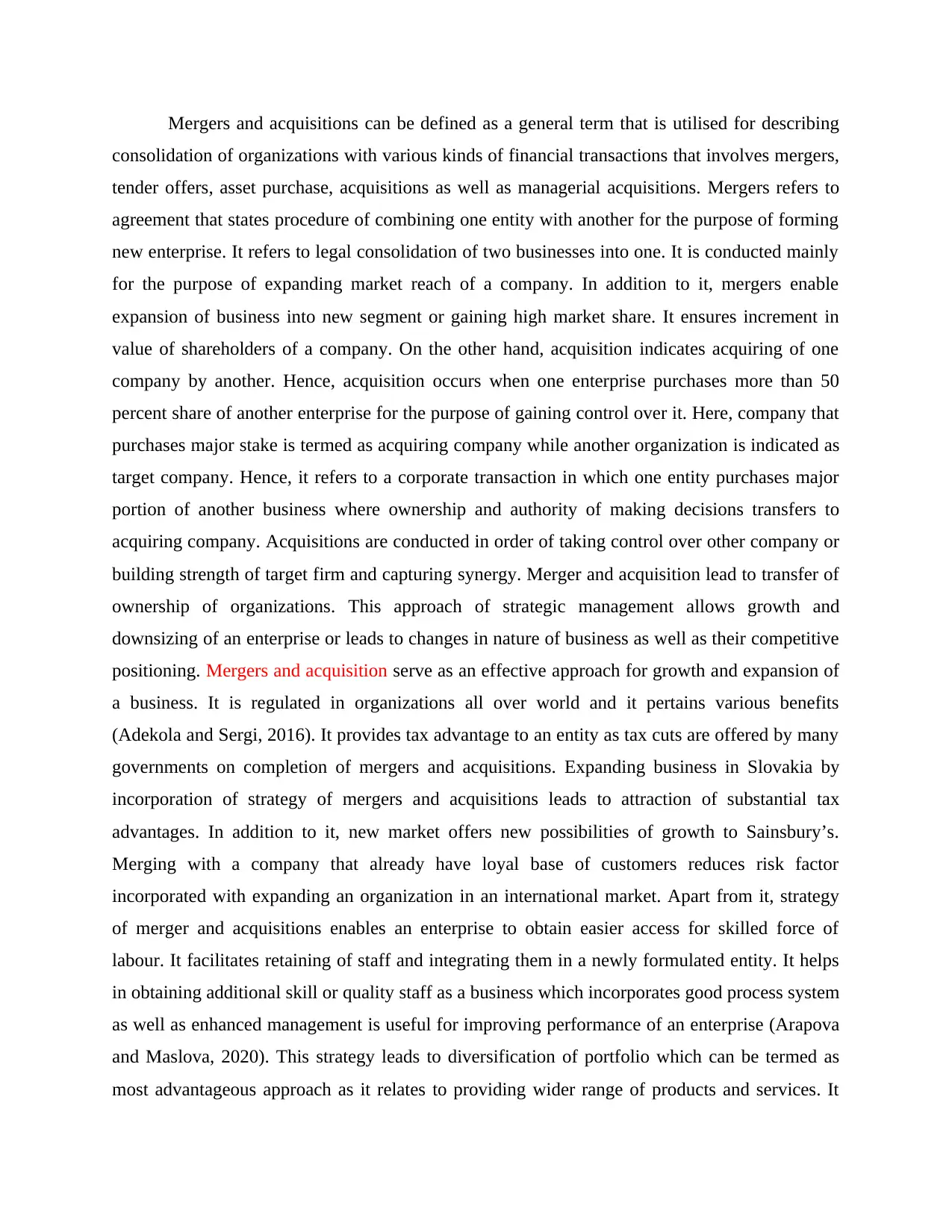
Mergers and acquisitions can be defined as a general term that is utilised for describing
consolidation of organizations with various kinds of financial transactions that involves mergers,
tender offers, asset purchase, acquisitions as well as managerial acquisitions. Mergers refers to
agreement that states procedure of combining one entity with another for the purpose of forming
new enterprise. It refers to legal consolidation of two businesses into one. It is conducted mainly
for the purpose of expanding market reach of a company. In addition to it, mergers enable
expansion of business into new segment or gaining high market share. It ensures increment in
value of shareholders of a company. On the other hand, acquisition indicates acquiring of one
company by another. Hence, acquisition occurs when one enterprise purchases more than 50
percent share of another enterprise for the purpose of gaining control over it. Here, company that
purchases major stake is termed as acquiring company while another organization is indicated as
target company. Hence, it refers to a corporate transaction in which one entity purchases major
portion of another business where ownership and authority of making decisions transfers to
acquiring company. Acquisitions are conducted in order of taking control over other company or
building strength of target firm and capturing synergy. Merger and acquisition lead to transfer of
ownership of organizations. This approach of strategic management allows growth and
downsizing of an enterprise or leads to changes in nature of business as well as their competitive
positioning. Mergers and acquisition serve as an effective approach for growth and expansion of
a business. It is regulated in organizations all over world and it pertains various benefits
(Adekola and Sergi, 2016). It provides tax advantage to an entity as tax cuts are offered by many
governments on completion of mergers and acquisitions. Expanding business in Slovakia by
incorporation of strategy of mergers and acquisitions leads to attraction of substantial tax
advantages. In addition to it, new market offers new possibilities of growth to Sainsbury’s.
Merging with a company that already have loyal base of customers reduces risk factor
incorporated with expanding an organization in an international market. Apart from it, strategy
of merger and acquisitions enables an enterprise to obtain easier access for skilled force of
labour. It facilitates retaining of staff and integrating them in a newly formulated entity. It helps
in obtaining additional skill or quality staff as a business which incorporates good process system
as well as enhanced management is useful for improving performance of an enterprise (Arapova
and Maslova, 2020). This strategy leads to diversification of portfolio which can be termed as
most advantageous approach as it relates to providing wider range of products and services. It
consolidation of organizations with various kinds of financial transactions that involves mergers,
tender offers, asset purchase, acquisitions as well as managerial acquisitions. Mergers refers to
agreement that states procedure of combining one entity with another for the purpose of forming
new enterprise. It refers to legal consolidation of two businesses into one. It is conducted mainly
for the purpose of expanding market reach of a company. In addition to it, mergers enable
expansion of business into new segment or gaining high market share. It ensures increment in
value of shareholders of a company. On the other hand, acquisition indicates acquiring of one
company by another. Hence, acquisition occurs when one enterprise purchases more than 50
percent share of another enterprise for the purpose of gaining control over it. Here, company that
purchases major stake is termed as acquiring company while another organization is indicated as
target company. Hence, it refers to a corporate transaction in which one entity purchases major
portion of another business where ownership and authority of making decisions transfers to
acquiring company. Acquisitions are conducted in order of taking control over other company or
building strength of target firm and capturing synergy. Merger and acquisition lead to transfer of
ownership of organizations. This approach of strategic management allows growth and
downsizing of an enterprise or leads to changes in nature of business as well as their competitive
positioning. Mergers and acquisition serve as an effective approach for growth and expansion of
a business. It is regulated in organizations all over world and it pertains various benefits
(Adekola and Sergi, 2016). It provides tax advantage to an entity as tax cuts are offered by many
governments on completion of mergers and acquisitions. Expanding business in Slovakia by
incorporation of strategy of mergers and acquisitions leads to attraction of substantial tax
advantages. In addition to it, new market offers new possibilities of growth to Sainsbury’s.
Merging with a company that already have loyal base of customers reduces risk factor
incorporated with expanding an organization in an international market. Apart from it, strategy
of merger and acquisitions enables an enterprise to obtain easier access for skilled force of
labour. It facilitates retaining of staff and integrating them in a newly formulated entity. It helps
in obtaining additional skill or quality staff as a business which incorporates good process system
as well as enhanced management is useful for improving performance of an enterprise (Arapova
and Maslova, 2020). This strategy leads to diversification of portfolio which can be termed as
most advantageous approach as it relates to providing wider range of products and services. It
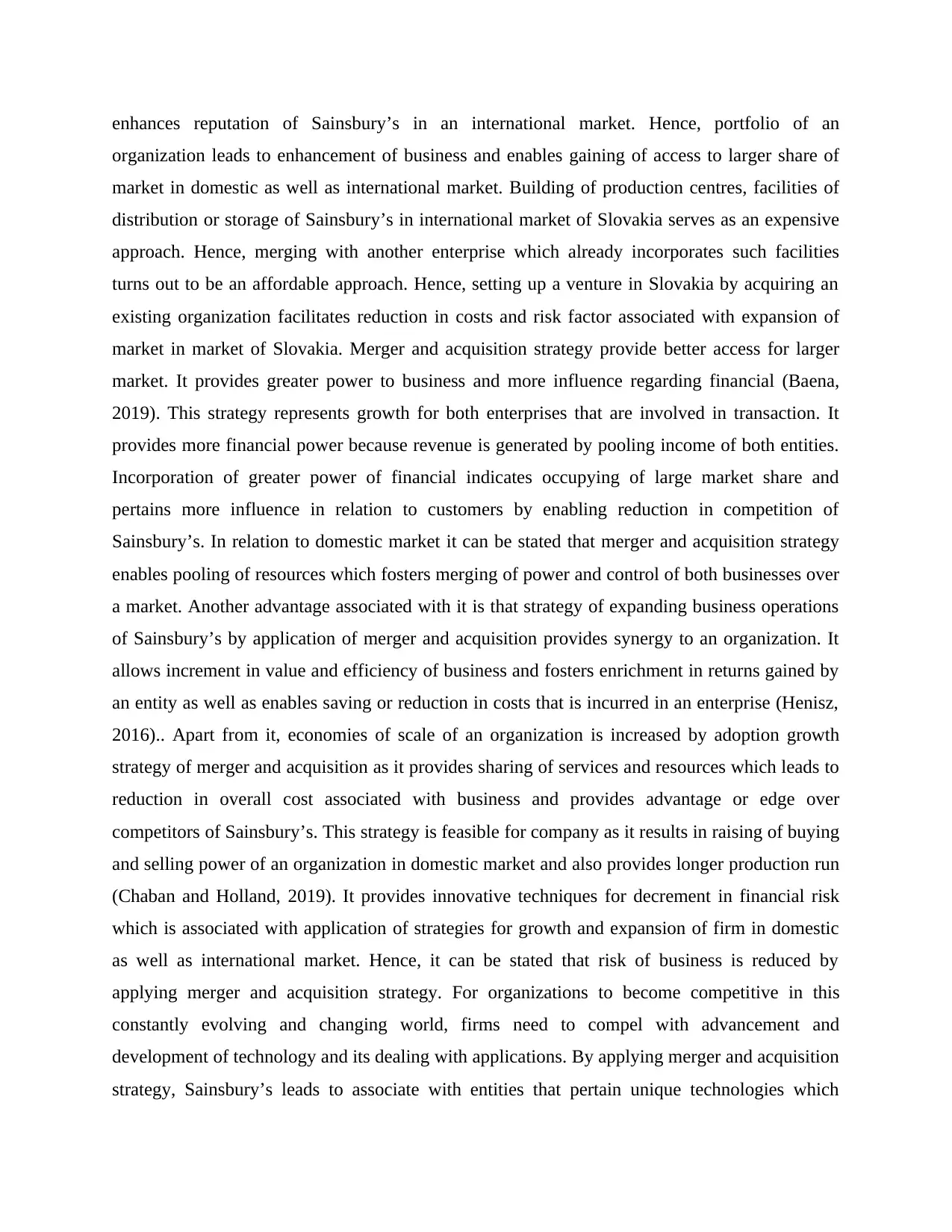
enhances reputation of Sainsbury’s in an international market. Hence, portfolio of an
organization leads to enhancement of business and enables gaining of access to larger share of
market in domestic as well as international market. Building of production centres, facilities of
distribution or storage of Sainsbury’s in international market of Slovakia serves as an expensive
approach. Hence, merging with another enterprise which already incorporates such facilities
turns out to be an affordable approach. Hence, setting up a venture in Slovakia by acquiring an
existing organization facilitates reduction in costs and risk factor associated with expansion of
market in market of Slovakia. Merger and acquisition strategy provide better access for larger
market. It provides greater power to business and more influence regarding financial (Baena,
2019). This strategy represents growth for both enterprises that are involved in transaction. It
provides more financial power because revenue is generated by pooling income of both entities.
Incorporation of greater power of financial indicates occupying of large market share and
pertains more influence in relation to customers by enabling reduction in competition of
Sainsbury’s. In relation to domestic market it can be stated that merger and acquisition strategy
enables pooling of resources which fosters merging of power and control of both businesses over
a market. Another advantage associated with it is that strategy of expanding business operations
of Sainsbury’s by application of merger and acquisition provides synergy to an organization. It
allows increment in value and efficiency of business and fosters enrichment in returns gained by
an entity as well as enables saving or reduction in costs that is incurred in an enterprise (Henisz,
2016).. Apart from it, economies of scale of an organization is increased by adoption growth
strategy of merger and acquisition as it provides sharing of services and resources which leads to
reduction in overall cost associated with business and provides advantage or edge over
competitors of Sainsbury’s. This strategy is feasible for company as it results in raising of buying
and selling power of an organization in domestic market and also provides longer production run
(Chaban and Holland, 2019). It provides innovative techniques for decrement in financial risk
which is associated with application of strategies for growth and expansion of firm in domestic
as well as international market. Hence, it can be stated that risk of business is reduced by
applying merger and acquisition strategy. For organizations to become competitive in this
constantly evolving and changing world, firms need to compel with advancement and
development of technology and its dealing with applications. By applying merger and acquisition
strategy, Sainsbury’s leads to associate with entities that pertain unique technologies which
organization leads to enhancement of business and enables gaining of access to larger share of
market in domestic as well as international market. Building of production centres, facilities of
distribution or storage of Sainsbury’s in international market of Slovakia serves as an expensive
approach. Hence, merging with another enterprise which already incorporates such facilities
turns out to be an affordable approach. Hence, setting up a venture in Slovakia by acquiring an
existing organization facilitates reduction in costs and risk factor associated with expansion of
market in market of Slovakia. Merger and acquisition strategy provide better access for larger
market. It provides greater power to business and more influence regarding financial (Baena,
2019). This strategy represents growth for both enterprises that are involved in transaction. It
provides more financial power because revenue is generated by pooling income of both entities.
Incorporation of greater power of financial indicates occupying of large market share and
pertains more influence in relation to customers by enabling reduction in competition of
Sainsbury’s. In relation to domestic market it can be stated that merger and acquisition strategy
enables pooling of resources which fosters merging of power and control of both businesses over
a market. Another advantage associated with it is that strategy of expanding business operations
of Sainsbury’s by application of merger and acquisition provides synergy to an organization. It
allows increment in value and efficiency of business and fosters enrichment in returns gained by
an entity as well as enables saving or reduction in costs that is incurred in an enterprise (Henisz,
2016).. Apart from it, economies of scale of an organization is increased by adoption growth
strategy of merger and acquisition as it provides sharing of services and resources which leads to
reduction in overall cost associated with business and provides advantage or edge over
competitors of Sainsbury’s. This strategy is feasible for company as it results in raising of buying
and selling power of an organization in domestic market and also provides longer production run
(Chaban and Holland, 2019). It provides innovative techniques for decrement in financial risk
which is associated with application of strategies for growth and expansion of firm in domestic
as well as international market. Hence, it can be stated that risk of business is reduced by
applying merger and acquisition strategy. For organizations to become competitive in this
constantly evolving and changing world, firms need to compel with advancement and
development of technology and its dealing with applications. By applying merger and acquisition
strategy, Sainsbury’s leads to associate with entities that pertain unique technologies which
⊘ This is a preview!⊘
Do you want full access?
Subscribe today to unlock all pages.

Trusted by 1+ million students worldwide
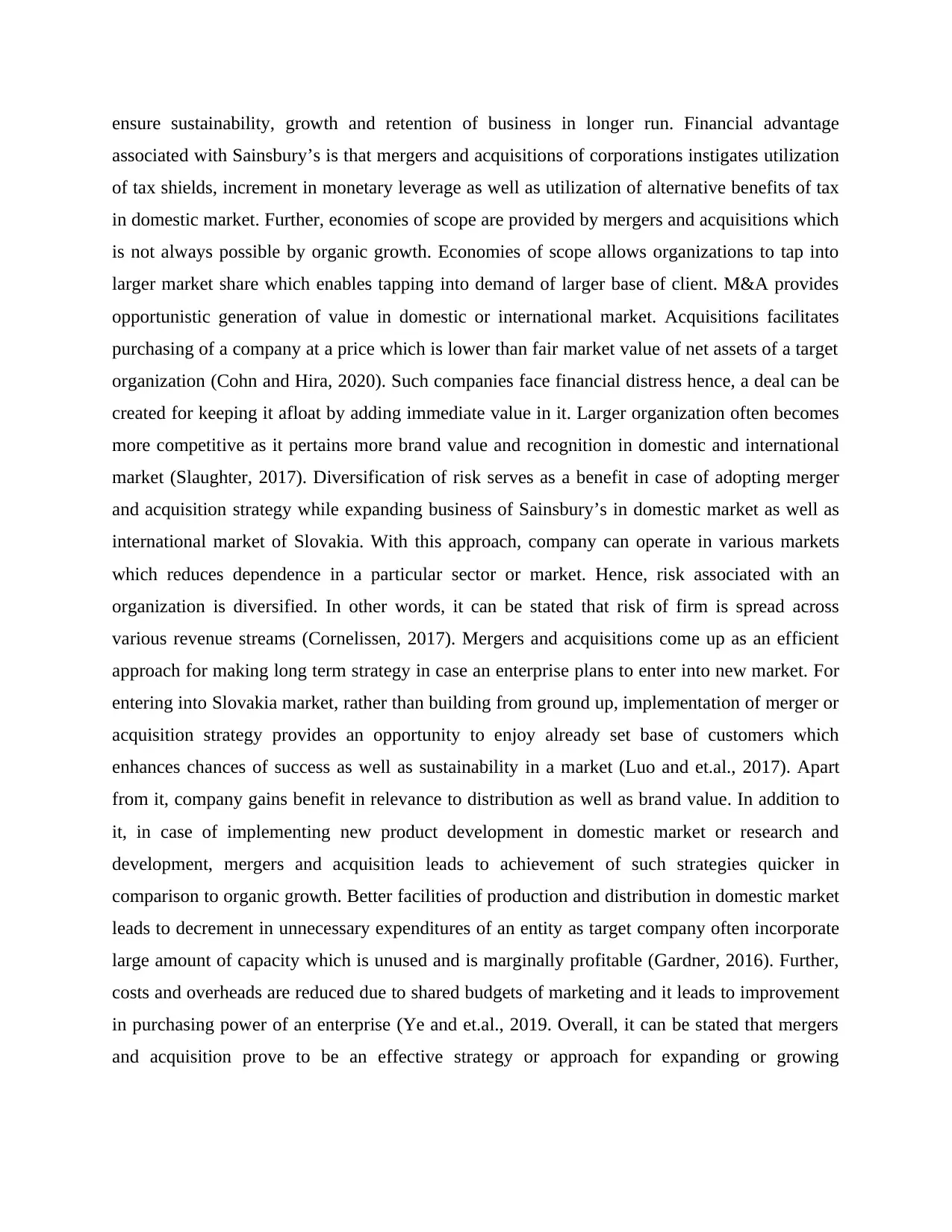
ensure sustainability, growth and retention of business in longer run. Financial advantage
associated with Sainsbury’s is that mergers and acquisitions of corporations instigates utilization
of tax shields, increment in monetary leverage as well as utilization of alternative benefits of tax
in domestic market. Further, economies of scope are provided by mergers and acquisitions which
is not always possible by organic growth. Economies of scope allows organizations to tap into
larger market share which enables tapping into demand of larger base of client. M&A provides
opportunistic generation of value in domestic or international market. Acquisitions facilitates
purchasing of a company at a price which is lower than fair market value of net assets of a target
organization (Cohn and Hira, 2020). Such companies face financial distress hence, a deal can be
created for keeping it afloat by adding immediate value in it. Larger organization often becomes
more competitive as it pertains more brand value and recognition in domestic and international
market (Slaughter, 2017). Diversification of risk serves as a benefit in case of adopting merger
and acquisition strategy while expanding business of Sainsbury’s in domestic market as well as
international market of Slovakia. With this approach, company can operate in various markets
which reduces dependence in a particular sector or market. Hence, risk associated with an
organization is diversified. In other words, it can be stated that risk of firm is spread across
various revenue streams (Cornelissen, 2017). Mergers and acquisitions come up as an efficient
approach for making long term strategy in case an enterprise plans to enter into new market. For
entering into Slovakia market, rather than building from ground up, implementation of merger or
acquisition strategy provides an opportunity to enjoy already set base of customers which
enhances chances of success as well as sustainability in a market (Luo and et.al., 2017). Apart
from it, company gains benefit in relevance to distribution as well as brand value. In addition to
it, in case of implementing new product development in domestic market or research and
development, mergers and acquisition leads to achievement of such strategies quicker in
comparison to organic growth. Better facilities of production and distribution in domestic market
leads to decrement in unnecessary expenditures of an entity as target company often incorporate
large amount of capacity which is unused and is marginally profitable (Gardner, 2016). Further,
costs and overheads are reduced due to shared budgets of marketing and it leads to improvement
in purchasing power of an enterprise (Ye and et.al., 2019. Overall, it can be stated that mergers
and acquisition prove to be an effective strategy or approach for expanding or growing
associated with Sainsbury’s is that mergers and acquisitions of corporations instigates utilization
of tax shields, increment in monetary leverage as well as utilization of alternative benefits of tax
in domestic market. Further, economies of scope are provided by mergers and acquisitions which
is not always possible by organic growth. Economies of scope allows organizations to tap into
larger market share which enables tapping into demand of larger base of client. M&A provides
opportunistic generation of value in domestic or international market. Acquisitions facilitates
purchasing of a company at a price which is lower than fair market value of net assets of a target
organization (Cohn and Hira, 2020). Such companies face financial distress hence, a deal can be
created for keeping it afloat by adding immediate value in it. Larger organization often becomes
more competitive as it pertains more brand value and recognition in domestic and international
market (Slaughter, 2017). Diversification of risk serves as a benefit in case of adopting merger
and acquisition strategy while expanding business of Sainsbury’s in domestic market as well as
international market of Slovakia. With this approach, company can operate in various markets
which reduces dependence in a particular sector or market. Hence, risk associated with an
organization is diversified. In other words, it can be stated that risk of firm is spread across
various revenue streams (Cornelissen, 2017). Mergers and acquisitions come up as an efficient
approach for making long term strategy in case an enterprise plans to enter into new market. For
entering into Slovakia market, rather than building from ground up, implementation of merger or
acquisition strategy provides an opportunity to enjoy already set base of customers which
enhances chances of success as well as sustainability in a market (Luo and et.al., 2017). Apart
from it, company gains benefit in relevance to distribution as well as brand value. In addition to
it, in case of implementing new product development in domestic market or research and
development, mergers and acquisition leads to achievement of such strategies quicker in
comparison to organic growth. Better facilities of production and distribution in domestic market
leads to decrement in unnecessary expenditures of an entity as target company often incorporate
large amount of capacity which is unused and is marginally profitable (Gardner, 2016). Further,
costs and overheads are reduced due to shared budgets of marketing and it leads to improvement
in purchasing power of an enterprise (Ye and et.al., 2019. Overall, it can be stated that mergers
and acquisition prove to be an effective strategy or approach for expanding or growing
Paraphrase This Document
Need a fresh take? Get an instant paraphrase of this document with our AI Paraphraser
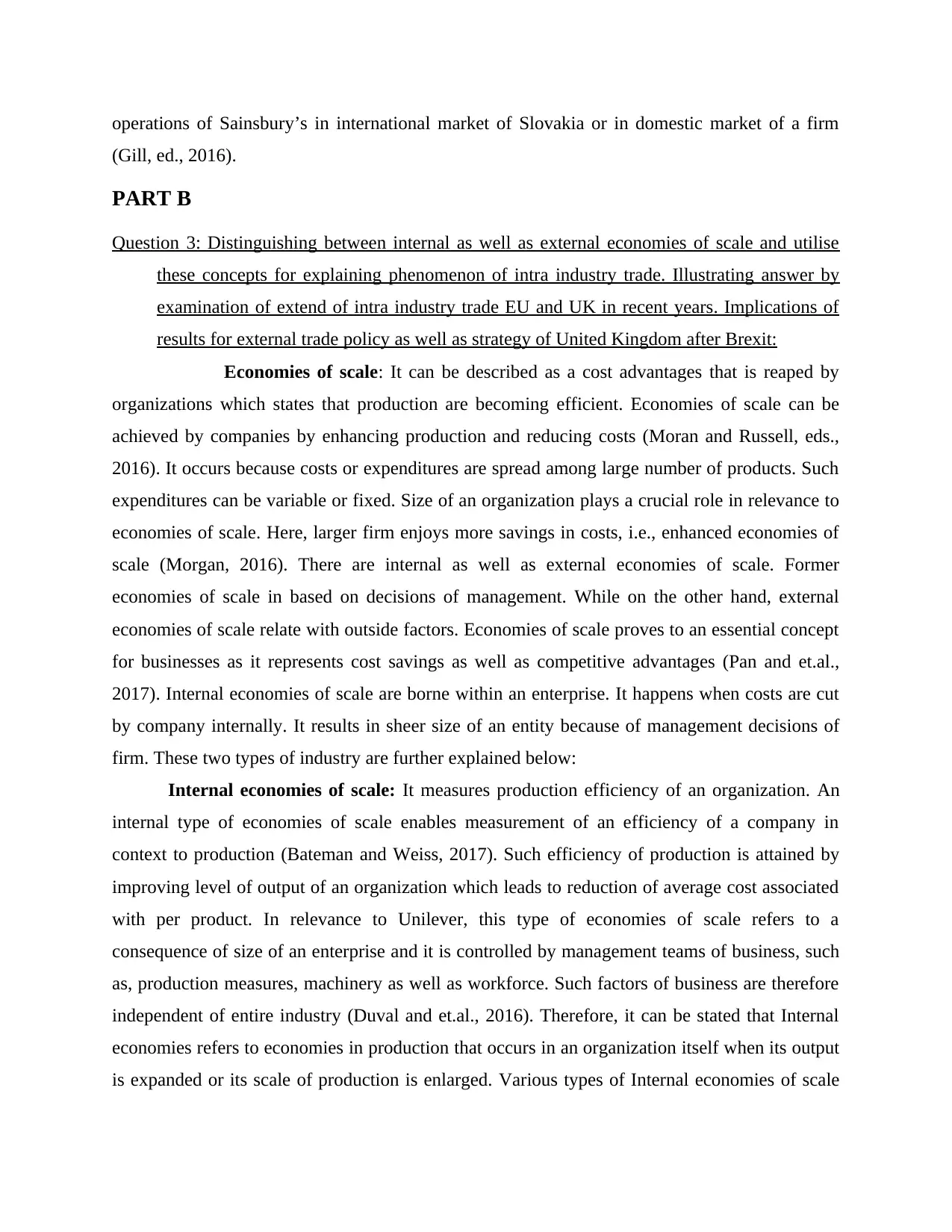
operations of Sainsbury’s in international market of Slovakia or in domestic market of a firm
(Gill, ed., 2016).
PART B
Question 3: Distinguishing between internal as well as external economies of scale and utilise
these concepts for explaining phenomenon of intra industry trade. Illustrating answer by
examination of extend of intra industry trade EU and UK in recent years. Implications of
results for external trade policy as well as strategy of United Kingdom after Brexit:
Economies of scale: It can be described as a cost advantages that is reaped by
organizations which states that production are becoming efficient. Economies of scale can be
achieved by companies by enhancing production and reducing costs (Moran and Russell, eds.,
2016). It occurs because costs or expenditures are spread among large number of products. Such
expenditures can be variable or fixed. Size of an organization plays a crucial role in relevance to
economies of scale. Here, larger firm enjoys more savings in costs, i.e., enhanced economies of
scale (Morgan, 2016). There are internal as well as external economies of scale. Former
economies of scale in based on decisions of management. While on the other hand, external
economies of scale relate with outside factors. Economies of scale proves to an essential concept
for businesses as it represents cost savings as well as competitive advantages (Pan and et.al.,
2017). Internal economies of scale are borne within an enterprise. It happens when costs are cut
by company internally. It results in sheer size of an entity because of management decisions of
firm. These two types of industry are further explained below:
Internal economies of scale: It measures production efficiency of an organization. An
internal type of economies of scale enables measurement of an efficiency of a company in
context to production (Bateman and Weiss, 2017). Such efficiency of production is attained by
improving level of output of an organization which leads to reduction of average cost associated
with per product. In relevance to Unilever, this type of economies of scale refers to a
consequence of size of an enterprise and it is controlled by management teams of business, such
as, production measures, machinery as well as workforce. Such factors of business are therefore
independent of entire industry (Duval and et.al., 2016). Therefore, it can be stated that Internal
economies refers to economies in production that occurs in an organization itself when its output
is expanded or its scale of production is enlarged. Various types of Internal economies of scale
(Gill, ed., 2016).
PART B
Question 3: Distinguishing between internal as well as external economies of scale and utilise
these concepts for explaining phenomenon of intra industry trade. Illustrating answer by
examination of extend of intra industry trade EU and UK in recent years. Implications of
results for external trade policy as well as strategy of United Kingdom after Brexit:
Economies of scale: It can be described as a cost advantages that is reaped by
organizations which states that production are becoming efficient. Economies of scale can be
achieved by companies by enhancing production and reducing costs (Moran and Russell, eds.,
2016). It occurs because costs or expenditures are spread among large number of products. Such
expenditures can be variable or fixed. Size of an organization plays a crucial role in relevance to
economies of scale. Here, larger firm enjoys more savings in costs, i.e., enhanced economies of
scale (Morgan, 2016). There are internal as well as external economies of scale. Former
economies of scale in based on decisions of management. While on the other hand, external
economies of scale relate with outside factors. Economies of scale proves to an essential concept
for businesses as it represents cost savings as well as competitive advantages (Pan and et.al.,
2017). Internal economies of scale are borne within an enterprise. It happens when costs are cut
by company internally. It results in sheer size of an entity because of management decisions of
firm. These two types of industry are further explained below:
Internal economies of scale: It measures production efficiency of an organization. An
internal type of economies of scale enables measurement of an efficiency of a company in
context to production (Bateman and Weiss, 2017). Such efficiency of production is attained by
improving level of output of an organization which leads to reduction of average cost associated
with per product. In relevance to Unilever, this type of economies of scale refers to a
consequence of size of an enterprise and it is controlled by management teams of business, such
as, production measures, machinery as well as workforce. Such factors of business are therefore
independent of entire industry (Duval and et.al., 2016). Therefore, it can be stated that Internal
economies refers to economies in production that occurs in an organization itself when its output
is expanded or its scale of production is enlarged. Various types of Internal economies of scale
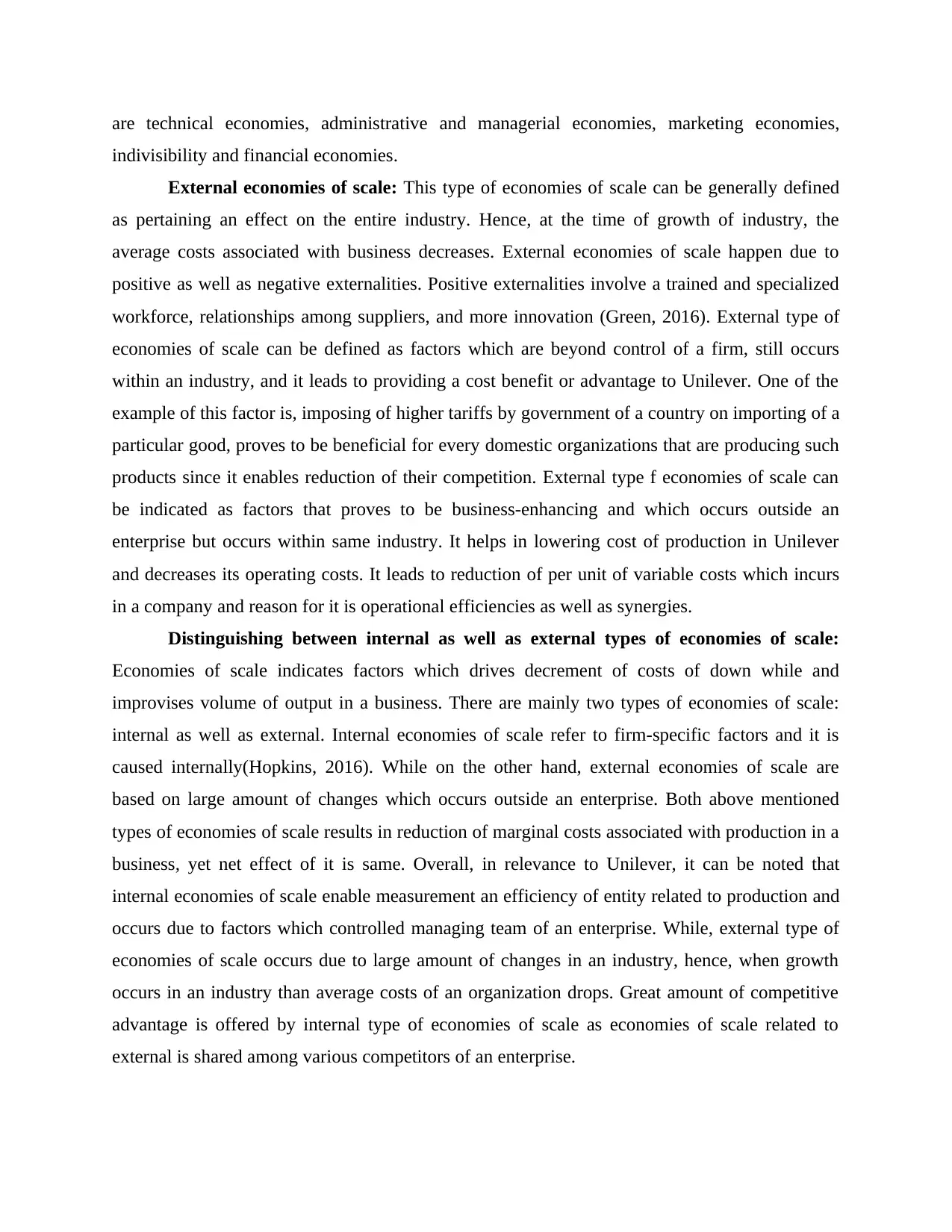
are technical economies, administrative and managerial economies, marketing economies,
indivisibility and financial economies.
External economies of scale: This type of economies of scale can be generally defined
as pertaining an effect on the entire industry. Hence, at the time of growth of industry, the
average costs associated with business decreases. External economies of scale happen due to
positive as well as negative externalities. Positive externalities involve a trained and specialized
workforce, relationships among suppliers, and more innovation (Green, 2016). External type of
economies of scale can be defined as factors which are beyond control of a firm, still occurs
within an industry, and it leads to providing a cost benefit or advantage to Unilever. One of the
example of this factor is, imposing of higher tariffs by government of a country on importing of a
particular good, proves to be beneficial for every domestic organizations that are producing such
products since it enables reduction of their competition. External type f economies of scale can
be indicated as factors that proves to be business-enhancing and which occurs outside an
enterprise but occurs within same industry. It helps in lowering cost of production in Unilever
and decreases its operating costs. It leads to reduction of per unit of variable costs which incurs
in a company and reason for it is operational efficiencies as well as synergies.
Distinguishing between internal as well as external types of economies of scale:
Economies of scale indicates factors which drives decrement of costs of down while and
improvises volume of output in a business. There are mainly two types of economies of scale:
internal as well as external. Internal economies of scale refer to firm-specific factors and it is
caused internally(Hopkins, 2016). While on the other hand, external economies of scale are
based on large amount of changes which occurs outside an enterprise. Both above mentioned
types of economies of scale results in reduction of marginal costs associated with production in a
business, yet net effect of it is same. Overall, in relevance to Unilever, it can be noted that
internal economies of scale enable measurement an efficiency of entity related to production and
occurs due to factors which controlled managing team of an enterprise. While, external type of
economies of scale occurs due to large amount of changes in an industry, hence, when growth
occurs in an industry than average costs of an organization drops. Great amount of competitive
advantage is offered by internal type of economies of scale as economies of scale related to
external is shared among various competitors of an enterprise.
indivisibility and financial economies.
External economies of scale: This type of economies of scale can be generally defined
as pertaining an effect on the entire industry. Hence, at the time of growth of industry, the
average costs associated with business decreases. External economies of scale happen due to
positive as well as negative externalities. Positive externalities involve a trained and specialized
workforce, relationships among suppliers, and more innovation (Green, 2016). External type of
economies of scale can be defined as factors which are beyond control of a firm, still occurs
within an industry, and it leads to providing a cost benefit or advantage to Unilever. One of the
example of this factor is, imposing of higher tariffs by government of a country on importing of a
particular good, proves to be beneficial for every domestic organizations that are producing such
products since it enables reduction of their competition. External type f economies of scale can
be indicated as factors that proves to be business-enhancing and which occurs outside an
enterprise but occurs within same industry. It helps in lowering cost of production in Unilever
and decreases its operating costs. It leads to reduction of per unit of variable costs which incurs
in a company and reason for it is operational efficiencies as well as synergies.
Distinguishing between internal as well as external types of economies of scale:
Economies of scale indicates factors which drives decrement of costs of down while and
improvises volume of output in a business. There are mainly two types of economies of scale:
internal as well as external. Internal economies of scale refer to firm-specific factors and it is
caused internally(Hopkins, 2016). While on the other hand, external economies of scale are
based on large amount of changes which occurs outside an enterprise. Both above mentioned
types of economies of scale results in reduction of marginal costs associated with production in a
business, yet net effect of it is same. Overall, in relevance to Unilever, it can be noted that
internal economies of scale enable measurement an efficiency of entity related to production and
occurs due to factors which controlled managing team of an enterprise. While, external type of
economies of scale occurs due to large amount of changes in an industry, hence, when growth
occurs in an industry than average costs of an organization drops. Great amount of competitive
advantage is offered by internal type of economies of scale as economies of scale related to
external is shared among various competitors of an enterprise.
⊘ This is a preview!⊘
Do you want full access?
Subscribe today to unlock all pages.

Trusted by 1+ million students worldwide
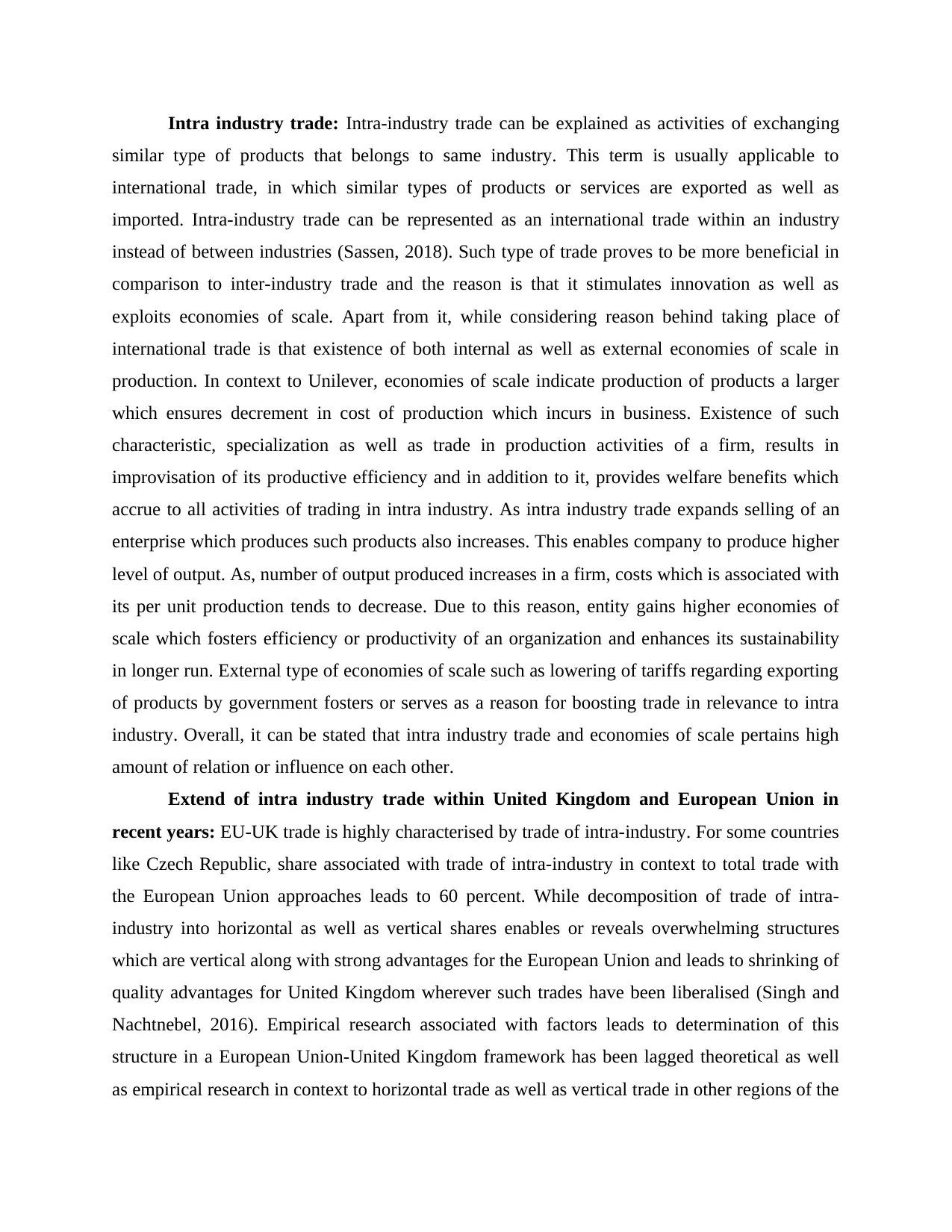
Intra industry trade: Intra-industry trade can be explained as activities of exchanging
similar type of products that belongs to same industry. This term is usually applicable to
international trade, in which similar types of products or services are exported as well as
imported. Intra-industry trade can be represented as an international trade within an industry
instead of between industries (Sassen, 2018). Such type of trade proves to be more beneficial in
comparison to inter-industry trade and the reason is that it stimulates innovation as well as
exploits economies of scale. Apart from it, while considering reason behind taking place of
international trade is that existence of both internal as well as external economies of scale in
production. In context to Unilever, economies of scale indicate production of products a larger
which ensures decrement in cost of production which incurs in business. Existence of such
characteristic, specialization as well as trade in production activities of a firm, results in
improvisation of its productive efficiency and in addition to it, provides welfare benefits which
accrue to all activities of trading in intra industry. As intra industry trade expands selling of an
enterprise which produces such products also increases. This enables company to produce higher
level of output. As, number of output produced increases in a firm, costs which is associated with
its per unit production tends to decrease. Due to this reason, entity gains higher economies of
scale which fosters efficiency or productivity of an organization and enhances its sustainability
in longer run. External type of economies of scale such as lowering of tariffs regarding exporting
of products by government fosters or serves as a reason for boosting trade in relevance to intra
industry. Overall, it can be stated that intra industry trade and economies of scale pertains high
amount of relation or influence on each other.
Extend of intra industry trade within United Kingdom and European Union in
recent years: EU-UK trade is highly characterised by trade of intra-industry. For some countries
like Czech Republic, share associated with trade of intra-industry in context to total trade with
the European Union approaches leads to 60 percent. While decomposition of trade of intra-
industry into horizontal as well as vertical shares enables or reveals overwhelming structures
which are vertical along with strong advantages for the European Union and leads to shrinking of
quality advantages for United Kingdom wherever such trades have been liberalised (Singh and
Nachtnebel, 2016). Empirical research associated with factors leads to determination of this
structure in a European Union-United Kingdom framework has been lagged theoretical as well
as empirical research in context to horizontal trade as well as vertical trade in other regions of the
similar type of products that belongs to same industry. This term is usually applicable to
international trade, in which similar types of products or services are exported as well as
imported. Intra-industry trade can be represented as an international trade within an industry
instead of between industries (Sassen, 2018). Such type of trade proves to be more beneficial in
comparison to inter-industry trade and the reason is that it stimulates innovation as well as
exploits economies of scale. Apart from it, while considering reason behind taking place of
international trade is that existence of both internal as well as external economies of scale in
production. In context to Unilever, economies of scale indicate production of products a larger
which ensures decrement in cost of production which incurs in business. Existence of such
characteristic, specialization as well as trade in production activities of a firm, results in
improvisation of its productive efficiency and in addition to it, provides welfare benefits which
accrue to all activities of trading in intra industry. As intra industry trade expands selling of an
enterprise which produces such products also increases. This enables company to produce higher
level of output. As, number of output produced increases in a firm, costs which is associated with
its per unit production tends to decrease. Due to this reason, entity gains higher economies of
scale which fosters efficiency or productivity of an organization and enhances its sustainability
in longer run. External type of economies of scale such as lowering of tariffs regarding exporting
of products by government fosters or serves as a reason for boosting trade in relevance to intra
industry. Overall, it can be stated that intra industry trade and economies of scale pertains high
amount of relation or influence on each other.
Extend of intra industry trade within United Kingdom and European Union in
recent years: EU-UK trade is highly characterised by trade of intra-industry. For some countries
like Czech Republic, share associated with trade of intra-industry in context to total trade with
the European Union approaches leads to 60 percent. While decomposition of trade of intra-
industry into horizontal as well as vertical shares enables or reveals overwhelming structures
which are vertical along with strong advantages for the European Union and leads to shrinking of
quality advantages for United Kingdom wherever such trades have been liberalised (Singh and
Nachtnebel, 2016). Empirical research associated with factors leads to determination of this
structure in a European Union-United Kingdom framework has been lagged theoretical as well
as empirical research in context to horizontal trade as well as vertical trade in other regions of the
Paraphrase This Document
Need a fresh take? Get an instant paraphrase of this document with our AI Paraphraser
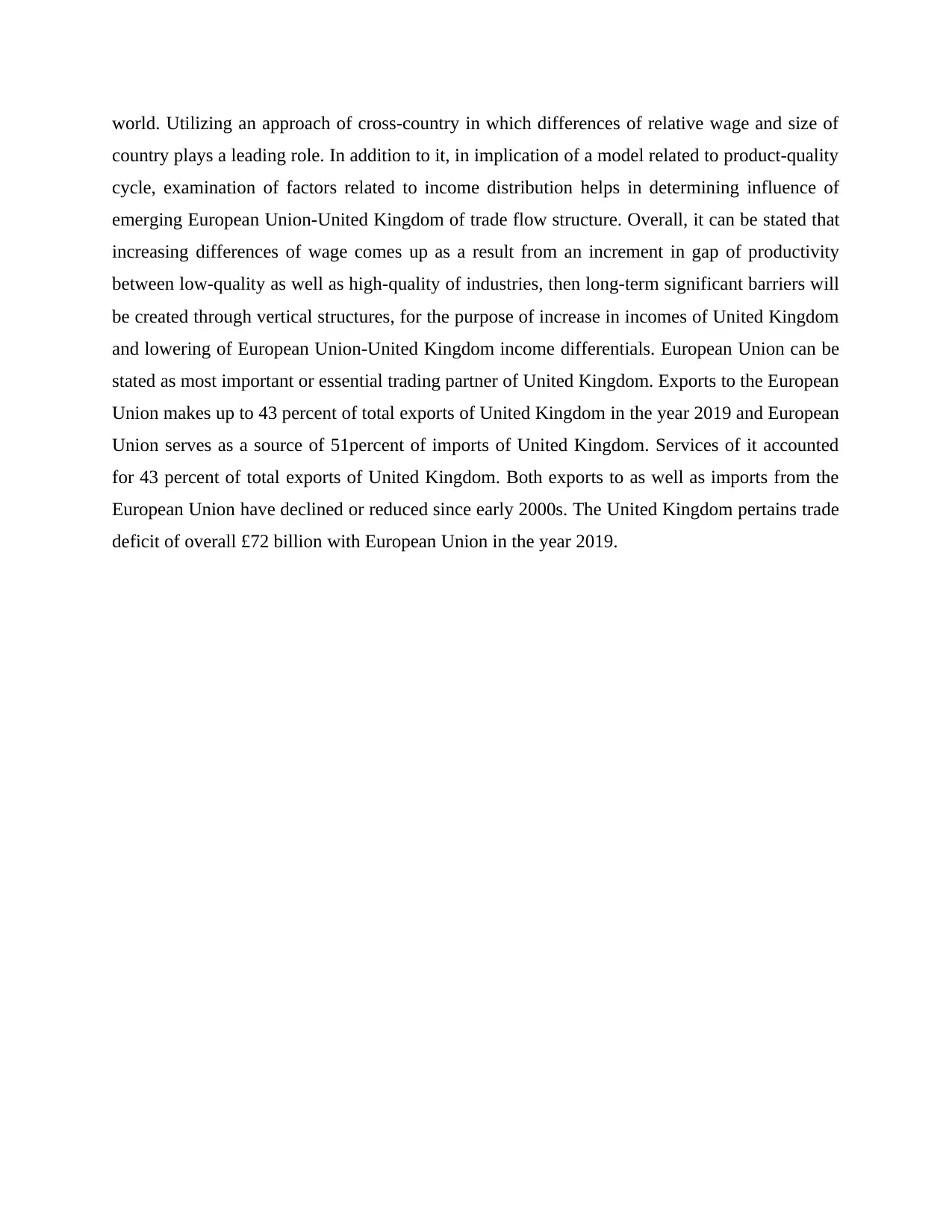
world. Utilizing an approach of cross-country in which differences of relative wage and size of
country plays a leading role. In addition to it, in implication of a model related to product-quality
cycle, examination of factors related to income distribution helps in determining influence of
emerging European Union-United Kingdom of trade flow structure. Overall, it can be stated that
increasing differences of wage comes up as a result from an increment in gap of productivity
between low-quality as well as high-quality of industries, then long-term significant barriers will
be created through vertical structures, for the purpose of increase in incomes of United Kingdom
and lowering of European Union-United Kingdom income differentials. European Union can be
stated as most important or essential trading partner of United Kingdom. Exports to the European
Union makes up to 43 percent of total exports of United Kingdom in the year 2019 and European
Union serves as a source of 51percent of imports of United Kingdom. Services of it accounted
for 43 percent of total exports of United Kingdom. Both exports to as well as imports from the
European Union have declined or reduced since early 2000s. The United Kingdom pertains trade
deficit of overall £72 billion with European Union in the year 2019.
country plays a leading role. In addition to it, in implication of a model related to product-quality
cycle, examination of factors related to income distribution helps in determining influence of
emerging European Union-United Kingdom of trade flow structure. Overall, it can be stated that
increasing differences of wage comes up as a result from an increment in gap of productivity
between low-quality as well as high-quality of industries, then long-term significant barriers will
be created through vertical structures, for the purpose of increase in incomes of United Kingdom
and lowering of European Union-United Kingdom income differentials. European Union can be
stated as most important or essential trading partner of United Kingdom. Exports to the European
Union makes up to 43 percent of total exports of United Kingdom in the year 2019 and European
Union serves as a source of 51percent of imports of United Kingdom. Services of it accounted
for 43 percent of total exports of United Kingdom. Both exports to as well as imports from the
European Union have declined or reduced since early 2000s. The United Kingdom pertains trade
deficit of overall £72 billion with European Union in the year 2019.
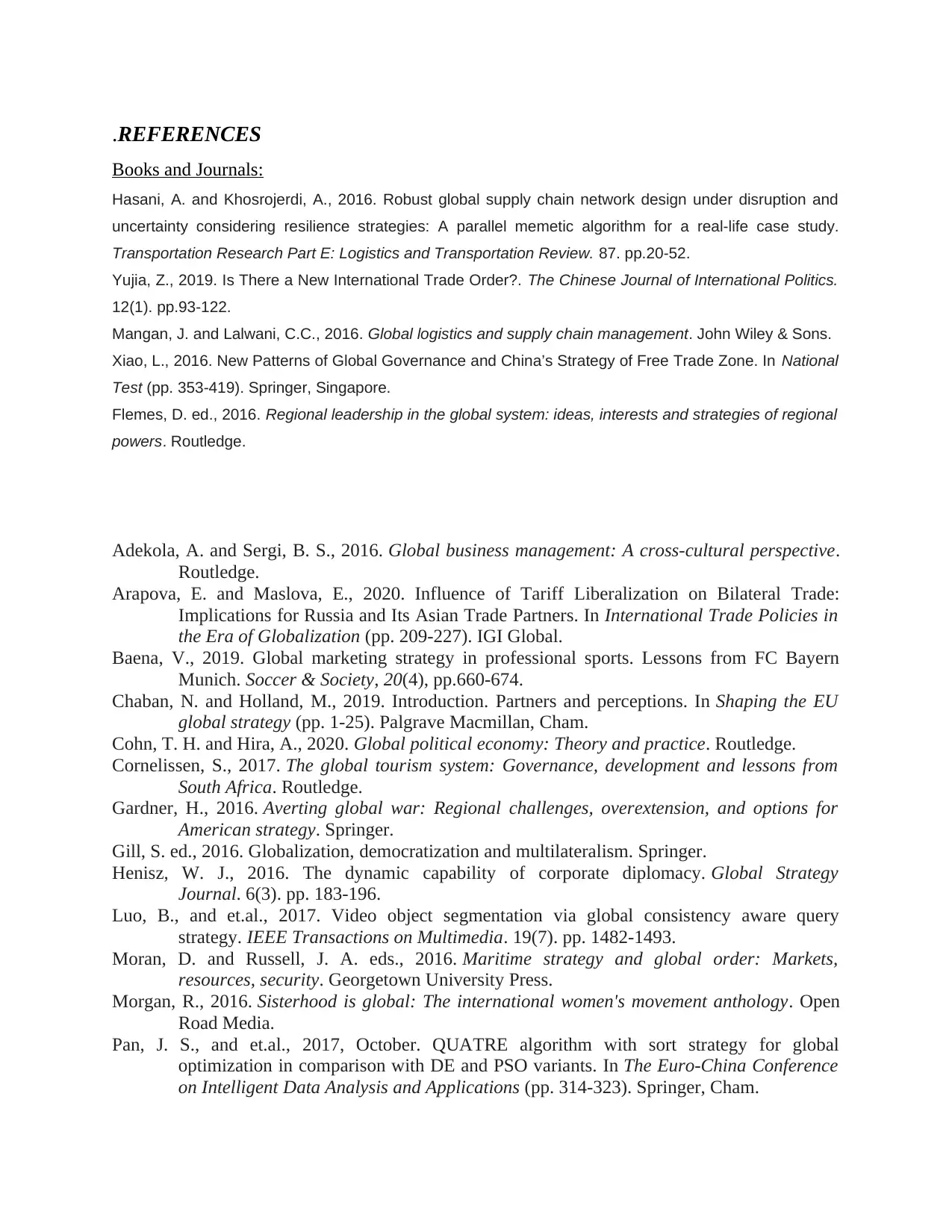
.REFERENCES
Books and Journals:
Hasani, A. and Khosrojerdi, A., 2016. Robust global supply chain network design under disruption and
uncertainty considering resilience strategies: A parallel memetic algorithm for a real-life case study.
Transportation Research Part E: Logistics and Transportation Review. 87. pp.20-52.
Yujia, Z., 2019. Is There a New International Trade Order?. The Chinese Journal of International Politics.
12(1). pp.93-122.
Mangan, J. and Lalwani, C.C., 2016. Global logistics and supply chain management. John Wiley & Sons.
Xiao, L., 2016. New Patterns of Global Governance and China’s Strategy of Free Trade Zone. In National
Test (pp. 353-419). Springer, Singapore.
Flemes, D. ed., 2016. Regional leadership in the global system: ideas, interests and strategies of regional
powers. Routledge.
Adekola, A. and Sergi, B. S., 2016. Global business management: A cross-cultural perspective.
Routledge.
Arapova, E. and Maslova, E., 2020. Influence of Tariff Liberalization on Bilateral Trade:
Implications for Russia and Its Asian Trade Partners. In International Trade Policies in
the Era of Globalization (pp. 209-227). IGI Global.
Baena, V., 2019. Global marketing strategy in professional sports. Lessons from FC Bayern
Munich. Soccer & Society, 20(4), pp.660-674.
Chaban, N. and Holland, M., 2019. Introduction. Partners and perceptions. In Shaping the EU
global strategy (pp. 1-25). Palgrave Macmillan, Cham.
Cohn, T. H. and Hira, A., 2020. Global political economy: Theory and practice. Routledge.
Cornelissen, S., 2017. The global tourism system: Governance, development and lessons from
South Africa. Routledge.
Gardner, H., 2016. Averting global war: Regional challenges, overextension, and options for
American strategy. Springer.
Gill, S. ed., 2016. Globalization, democratization and multilateralism. Springer.
Henisz, W. J., 2016. The dynamic capability of corporate diplomacy. Global Strategy
Journal. 6(3). pp. 183-196.
Luo, B., and et.al., 2017. Video object segmentation via global consistency aware query
strategy. IEEE Transactions on Multimedia. 19(7). pp. 1482-1493.
Moran, D. and Russell, J. A. eds., 2016. Maritime strategy and global order: Markets,
resources, security. Georgetown University Press.
Morgan, R., 2016. Sisterhood is global: The international women's movement anthology. Open
Road Media.
Pan, J. S., and et.al., 2017, October. QUATRE algorithm with sort strategy for global
optimization in comparison with DE and PSO variants. In The Euro-China Conference
on Intelligent Data Analysis and Applications (pp. 314-323). Springer, Cham.
Books and Journals:
Hasani, A. and Khosrojerdi, A., 2016. Robust global supply chain network design under disruption and
uncertainty considering resilience strategies: A parallel memetic algorithm for a real-life case study.
Transportation Research Part E: Logistics and Transportation Review. 87. pp.20-52.
Yujia, Z., 2019. Is There a New International Trade Order?. The Chinese Journal of International Politics.
12(1). pp.93-122.
Mangan, J. and Lalwani, C.C., 2016. Global logistics and supply chain management. John Wiley & Sons.
Xiao, L., 2016. New Patterns of Global Governance and China’s Strategy of Free Trade Zone. In National
Test (pp. 353-419). Springer, Singapore.
Flemes, D. ed., 2016. Regional leadership in the global system: ideas, interests and strategies of regional
powers. Routledge.
Adekola, A. and Sergi, B. S., 2016. Global business management: A cross-cultural perspective.
Routledge.
Arapova, E. and Maslova, E., 2020. Influence of Tariff Liberalization on Bilateral Trade:
Implications for Russia and Its Asian Trade Partners. In International Trade Policies in
the Era of Globalization (pp. 209-227). IGI Global.
Baena, V., 2019. Global marketing strategy in professional sports. Lessons from FC Bayern
Munich. Soccer & Society, 20(4), pp.660-674.
Chaban, N. and Holland, M., 2019. Introduction. Partners and perceptions. In Shaping the EU
global strategy (pp. 1-25). Palgrave Macmillan, Cham.
Cohn, T. H. and Hira, A., 2020. Global political economy: Theory and practice. Routledge.
Cornelissen, S., 2017. The global tourism system: Governance, development and lessons from
South Africa. Routledge.
Gardner, H., 2016. Averting global war: Regional challenges, overextension, and options for
American strategy. Springer.
Gill, S. ed., 2016. Globalization, democratization and multilateralism. Springer.
Henisz, W. J., 2016. The dynamic capability of corporate diplomacy. Global Strategy
Journal. 6(3). pp. 183-196.
Luo, B., and et.al., 2017. Video object segmentation via global consistency aware query
strategy. IEEE Transactions on Multimedia. 19(7). pp. 1482-1493.
Moran, D. and Russell, J. A. eds., 2016. Maritime strategy and global order: Markets,
resources, security. Georgetown University Press.
Morgan, R., 2016. Sisterhood is global: The international women's movement anthology. Open
Road Media.
Pan, J. S., and et.al., 2017, October. QUATRE algorithm with sort strategy for global
optimization in comparison with DE and PSO variants. In The Euro-China Conference
on Intelligent Data Analysis and Applications (pp. 314-323). Springer, Cham.
⊘ This is a preview!⊘
Do you want full access?
Subscribe today to unlock all pages.

Trusted by 1+ million students worldwide
1 out of 15
Related Documents
Your All-in-One AI-Powered Toolkit for Academic Success.
+13062052269
info@desklib.com
Available 24*7 on WhatsApp / Email
![[object Object]](/_next/static/media/star-bottom.7253800d.svg)
Unlock your academic potential
Copyright © 2020–2025 A2Z Services. All Rights Reserved. Developed and managed by ZUCOL.





